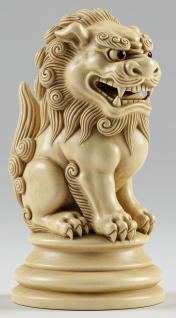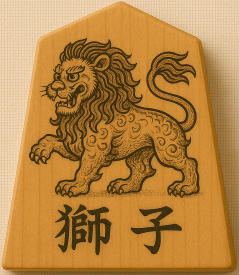Piececlopedia: Lion (獅子)
Historical notes


The lion is probably best known from the 12x12 shogi variant chu shogi, and also appears in the larger shogi variants. Its Japanese name of 獅子 is transliterated as shishi. The 獅 character by itself means lion, and it is used for the abbreviated version of the piece. The 子 character by itself means child.
Movement
The movement of the lion is fairly complicated. When it moves, it has the following options (see diagram below):
- the lion can move directly to a green square, capturing or not.
- the lion can move directly to any red square, leaping over intervening pieces if necessary, capturing or not.
- the lion can capture on a green square and return to its starting square in the same move. Such a capture is called igui.
- the lion can move to a green square and return to its starting square in the same move, effectively passing.
- the lion can capture on a green square, and then either move to any adjacent green or red square, capturing or not. Thus the lion can capture two pieces in one turn.
![]()
![]()
![]()
![]()
![]()
![]()
![]()
![]()
![]()
![]()
![]()
![]()
![]()
![]()
![]()
![]()
![]()
![]()
![]()
![]()
![]()
![]()
![]()
![]()
![]()
Remark
In chu shogi, additional rules exist concerning the lion:
- If your opponent's lion is at least two squares from your own lion and is protected by one of his own pieces, then it is illegal to capture his lion with your lion.
- If your lion is captured by a non-lion piece, it is illegal to capture your opponent's lion on the following turn.
- The exception to part one is as follows: if the two lions are two squares apart, and there is an enemy piece in between them that is not a go-between or a pawn, then it is legal to use your lion to capture the enemy piece and the enemy lion in the same turn.
The above rules are designed to make lion trades difficult, thus making it very likely that the lions will remain in the game until the very end. These rules do not appear in dai shogi and larger variants however, and thus should not be considered intrinsic properties of the lion.
The lion is an extremely powerful piece. In chu shogi, it is easily the most powerful piece on the board, much stronger than the free king, which has the powers of a chess queen.
This is an item in the Piececlopedia: an overview of different (fairy) chess pieces.
Written by Benjamin C Good.
WWW page created: September 14, 1998.
Last Updated: April 15, 2025.